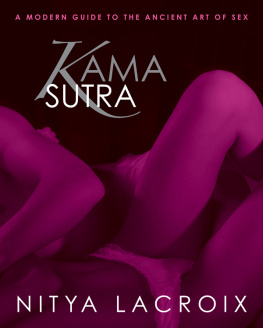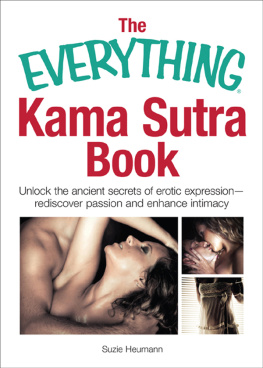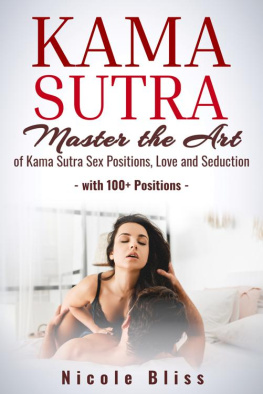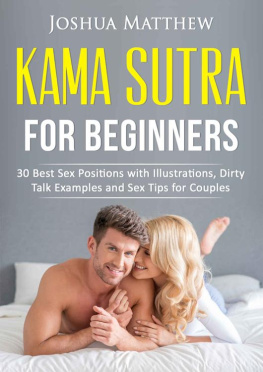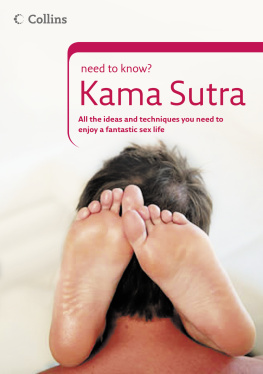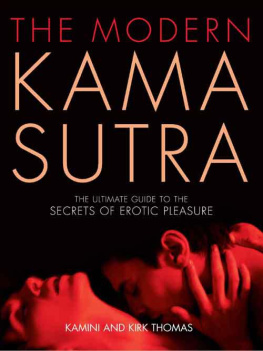Copyright 2003, 2014 by Nitya Lacroix
First published as Kama Sutra by Nitya Lacroix in 2003 by Hylas Publishing
All Rights Reserved. No part of this book may be reproduced in any manner without the express written consent of the publisher, except in the case of brief excerpts in critical reviews or articles. All inquiries should be addressed to Skyhorse Publishing, 307 West 36th Street, 11th Floor, New York, NY 10018.
Skyhorse Publishing books may be purchased in bulk at special discounts for sales promotion, corporate gifts, fund-raising, or educational purposes. Special editions can also be created to specifications. For details, contact the Special Sales Department, Skyhorse Publishing, 307 West 36th Street, 11th Floor, New York, NY 10018 or .
Skyhorse and Skyhorse Publishing are registered trademarks of Skyhorse Publishing, Inc., a Delaware corporation.
www.skyhorsepublishing.com
10 9 8 7 6 5 4 3 2 1
Library of Congress Cataloging-in-Publication Data is available on file.
ISBN: 978-1-62914-207-4
Printed in China

Contents
INTRODUCTION

... the Kama Sutra... a treatise on
men and women, their mutual
relationship, and connection with
each other.
S IR R ICHARD B URTON
What is the Kama Sutra?
In ancient India sense and sensuality were seen as two sides of the same coin. To embrace and enjoy sex was considered to be an integral part in the journey of life to be enjoyed without guilt. Sexuality was at the very heart of all Hindu culture, including poetry, art, and music. Ancient Hindu sages preached the importance of sexual love; temple walls and religious caves were carved with exquisitely erotic sculptures; and Hindu paintings detailed explicit sexual activities. One Hindu text has famously stood the test of time to become the definitive practical guide to great sex: the Kama Sutra of Vatsyayana.

MANY OF THE POSITIONS and practices described in the Kama Sutra have their origins in ancient tantric and yogic rituals. This artwork shows a woman in the position of the Wife of Indra (see ), combining sex with a yoga breathing exercise .
THE DEFINITIVE SEX GUIDE
The Kama Sutra was written by the sage Vatsyayana, probably some time in the 4th century. It is a compilation of the teachings of Hindu sages that were handed down over countless generations, and it had a profound influence on the social mores of Hindu society for centuries to follow. The sexual dictates were just a small part of the work, for the Kama Sutra also laid out the rules for entertaining and housekeeping; the duties of the husband and wife; and the role of the courtesan. However, it is Vatsyayanas vivid descriptions of sexual positions that had a major influence on Hindu artworks and writings over the centuries and, more recently, on Western culture too. Today, the term kama sutra is used to describe any collection of sexual positions, but especially more exotic or extravagant postures.
KAMA SHASTRA SOCIETY
The Kama Sutra was first published in England in 1883, during the notoriously sexually repressed Victorian era. It appeared in limited editions for private circulation to members of the Kama Shastra Society of London and Benares. The translation was the work of the enigmatic Victorian explorer Sir Richard Burton and his friend Forester Arbuthnot, a former civil servant in India. Both men shared a love of erotica and were dedicated to the translation and publication of exotic foreign texts, including the Arabian Nights .
SEXUAL REVOLUTION
When the Kama Sutra was published for the general readership at the height of the Western sexual revolution in the 1960s, people were astonished by the variety and descriptions of its lovemaking positions. In the West, sex had been a repressed subject for a long time and was viewed as a preserve for male enjoyment only. Womens sexuality and sexual needs were rarely discussed or even acknowledged. It was widely accepted that women put up with sex to please their husbands and to bear children. Suddenly, the West discovered what the East had known for thousands of yearsthat women were as orgasmic as men and could derive as much satisfaction and pleasure from sex as their partners. Not only that, the incredulous Western reader also discovered that there were many other lovemaking positions to be thoroughly enjoyed in addition to the male-dominant Missionary position.
KAMA TODAY
The Kama Sutra is remarkable for its non-judgmental and very pragmatic approach to sexual matters, and a great deal of its teaching remains relevant and interesting to the contemporary man and woman. The Kama Sutra certainly makes it very clear that the womans satisfaction is as important as the mans (and, fortunately, recent research confirms that most men now share this opinion). A fascinating modern translation by Wendy Doniger and Sudhir Kakar demonstrates that Vatsyayanas text was perhaps more liberal and egalitarian than was previously thought, and that Burtons translationthough a magnificent achievement for its timeis marred by Victorian squeamishness and indirect language that was not evident in the original Sanskrit. The new translators even go so far as to suggest that Burton occasionally adapted the text to incorporate Victorian values. A particularly blatant example is Burtons translation of Vatsyayanas description of what a woman should do when her husband is unfaithful: She should not blame him excessively, though she be a little displeased. She should not use abusive language toward him, but rebuke him with conciliatory words. The modern translation reveals that Vatsyayana actually advised that the woman should scold her husband with abusive language, whether he is alone or in company. These are two very different interpretations.

VATSYAYANAS VIVID descriptions of sexual positions have had a major influence on Hindu art. At Khajuraho, in central India, magnificent temples are adorned with erotic friezes depicting every imaginable sexual activity .
ANANGA RANGA
The Kama Sutra is not the only great Hindu work of its kind. The Ananga Ranga, written in the 15th century by the poet Kalyana Malla, specifically targeted married couples in the belief that sexual variety kept a relationship alive and that monotony was the main enemy of marriage. Wise advice even for modern times. This book draws on relevant sexual advice from both these famous Hindu works of eroticism and places it in a modern context.
SEXUAL BATTLEGROUND
Attitudes toward sex are constantly in flux, not only because of generational, religious, and cultural differences, but also because of ever-changing attitudes towards matters of health, economics, gender relationships, and social conditions. Sexual matters that shock one group of people may be regarded as trivial or merely titillating by another. Today, sex is no longer the taboo subject that it once was in the West. The pendulum has truly swung, and sex is all around us in the media, advertising, and the arts. All too often it is portrayed as a selling point without any emotional content. Frequently, it is presented as a battleground between men and women: who dominates, who gets the better orgasm, and who lasts longer. There is little mystery and romance to this modern-day depiction of sexuality. So, in the spirit of the original Kama Sutra, it is the aim of this book to remind ourselves that good sex is developed out of respect for the differences and the similarities of the sexual and emotional needs of men and women.

